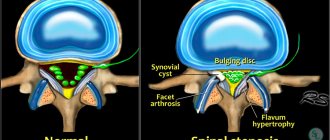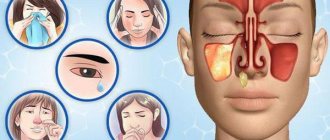Causes of pain
Painful sensations in the ear area and the right side of the head can occur due to inflammatory processes, as well as when the blood circulation in this area is impaired. The process can spread from the organ of hearing to part of the head and vice versa. When the first complaints appear, it is necessary to undergo an examination and determine their cause.
Otitis
Ear inflammation (otitis) can occur in adults and children. It occurs as a complication of viral diseases (ARVI, influenza), injuries, hypothermia or inflammation of the sinuses. At the first stage, the patient is bothered by constant pain in the ear, which spreads to the entire surface of the head. However, otitis media can progress and develop in several stages:
- aseptic inflammation, which causes aching pain;
- addition of a bacterial infection;
- development of purulent inflammation - accompanied by acute pain and hearing impairment;
- probable complications in the form of purulent melting of the eardrum, as well as the spread of infection to the inner ear and lining of the brain.
Otitis media is often chronic and appears annually. After an examination, an otolaryngologist will help you choose the most effective treatment regimen. It is important to pay attention to the first symptoms in time, since the chronic course of the inflammatory process can provoke partial or complete hearing loss.
Diseases of the external ear
The outer ear is the peripheral part of the hearing organ, which is separated from the middle part by the eardrum. Pathological processes in this area often manifest as acute pain in the right ear and head. With timely treatment, they resolve without complications, but in the absence of intervention they can spread to the middle and inner ear.
- Furunculosis, eczema, fungal skin infections - these processes are accompanied by inflammation and pain. The skin of the auricle turns red and peels, and ulcers (boils) may form on it. Treatment consists of external use of anti-inflammatory and antifungal drugs.
- Diseases that lead to the formation of cerumen plug - it forms deep in the ear canal, so it is impossible to remove it yourself. The cause may be anatomical features of the structure of the hearing organ or excessive formation of sulfur.
- Injuries, falls and bruises are another cause of inflammation of the outer ear. In young children, the process can be triggered by foreign objects entering the ear canal.
When diagnosing, it is important to assess the condition of the eardrum. Inflammatory processes can spread to it and even cause its perforation. Injuries that cause damage are also dangerous.
Inner ear diseases
Inflammation of the inner ear is the cause of acute pain in the right side of the head and in the ear. The organ has a complex structure and is responsible not only for hearing, but also for balance. It is presented in the form of channels and labyrinths filled with liquids. This is where bacteria multiply, causing inflammation.
Diseases of the inner ear require immediate treatment; in most cases, antibiotic therapy is used for this. The tympanic cavity is a comfortable environment for the growth of bacteria, and they can cause purulent inflammation. This leads to hearing loss, constant headaches, and the development of complications, including acute meningitis - inflammation of the membranes of the brain.
Change in blood pressure
An increase or decrease in blood pressure is a common reason why the right ear and the right side of the head hurt. Hypertension (high blood pressure) occurs due to insufficient elasticity of blood vessels, nervous tension and other factors. It manifests itself with characteristic symptoms:
- pressing headache that spreads to the back of the head, temple, and may affect the ear;
- deterioration of hearing and vision, the appearance of tinnitus;
- redness of the skin and mucous membranes, the appearance of small capillary hemorrhages.
With a decrease in pressure (hypotension), an increase in heart rate, weakness, and impaired coordination of movements are observed. The skin and mucous membranes may become pale. Insufficient oxygen supply to the brain is dangerous, as it can provoke a stroke or transistor ischemic attacks.
Stroke
Acute cerebrovascular accident is a stroke. It occurs when there is a sudden stop in the flow of oxygen-rich blood to certain areas of the brain. There are ischemic (manifested by blockage, compression of a vessel, low blood pressure) and hemorrhagic (the result of damage to an artery and hemorrhage in the brain) stroke. The first type is more common and is manifested by the following symptoms:
- sudden headache, often one-sided, which may affect the ear;
- impaired coordination of movements;
- weakening of the facial muscles on the injured side;
- discomfort and pain behind the sternum;
- impaired diction, the appearance of memory lapses;
- loss of consciousness.
The main reason why strokes occur is the lack of early diagnosis. Doctors at the Clinical Brain Institute recommend undergoing regular scheduled examinations to identify cardiovascular diseases in the early stages. Monitoring blood pressure, proper nutrition and dosed exercise, as well as systematically taking medications as needed are the basis for preventing stroke at any age.
Pain in the ear and right side of the head due to neuralgia
If your head hurts and radiates to your right ear, this may be a sign of neuralgia. This is not a separate disease, but a type of pain that occurs when a nerve is inflamed or damaged. The trigeminal nerve is most often affected, which gives off branches to the muscles of the face, the organ of hearing, the upper and lower jaws.
Neuritis is an inflammatory process that develops in nerve fibers. It is accompanied by acute throbbing pain, which can be one-sided, affecting part of the head, ear and half of the face. It intensifies with sharp sounds, bright lighting and other irritants, as well as with chewing and turning the head. Treatment consists of taking painkillers and anti-inflammatory drugs. If they are ineffective, a nerve block is indicated - injections along its course with anesthetics and hormonal anti-inflammatory drugs.
Diseases of the cervical spine
The cervical spine contains arteries that carry blood from the heart to the brain, analyzer organs, muscles and facial skin. Their mechanical pinching leads to impaired sensitivity in certain areas and chronic headaches. Normally, the vessels are located in the canals formed by the processes of the vertebrae, and blood moves freely through them. However, there are a number of diseases that lead to poor circulation, pain in the head and ear:
- osteochondrosis is a pathology of intervertebral discs, in which they become fragile and cannot absorb movement, and the distance between adjacent vertebrae decreases;
- spondylosis - fusion of two or more adjacent vertebrae as a result of injury, inflammatory or dystrophic changes, destruction of cartilage;
- curvature of the spine, most often cervical scoliosis;
- chondrocalcinosis - deposition of salts in the periarticular tissues, which leads to decreased joint mobility;
- intervertebral protrusions and hernias - protrusion of intervertebral discs, their gradual erasure until the outer fibrous membrane ruptures;
- vertebral displacement.
Spinal diseases often manifest as headaches. It can be one-sided, since the load on the spinal column becomes uneven, and mechanical compression of the vessels and nerves occurs.
Inflammation of the lymph nodes
Lymphadenitis is inflammation of the lymph nodes. Pain in the right ear and right side of the head can be caused by damage to the parotid lymph nodes. It is acute, pulsating, and may be accompanied by fever. The disease occurs as a complication of a viral infection of the upper respiratory tract; a bacterial or fungal pathogen can also be diagnosed.
With lymphadenitis, redness of the skin behind the ears and the appearance of a hard lump may be observed. The local temperature is increased and pulsation is felt. Treatment consists of taking antibiotics, anti-inflammatory drugs, and painkillers.
Stages of disease development
Treatment of acute otitis lasts from one to three weeks. There are several stages in the development of the disease. But it is not at all necessary that the patient will go through all of them. If treatment for infectious otitis is started on time and the acute disease is treated by a competent ENT doctor, recovery will not take long.
So, the course of the disease is conventionally divided into several stages:
- Catarrhal. Pathogenic microorganisms begin to actively multiply, triggering an inflammatory process in the ear. At this time, catarrhal edema and inflammation are observed.
- Exudative. Inflammation leads to active formation of fluid (secret). It accumulates and pathogenic microorganisms continue to multiply here. Timely treatment at this stage will allow you to cure otitis media, avoiding complications.
- Purulent. Acute purulent inflammation is characterized by increased formation of purulent masses in the middle ear cavity. They accumulate, the patient experiences pressure from the inside. The state of congestion does not go away. This phase usually lasts from several days to several hours.
- Perforated. At this stage, accumulated pus causes a rupture of the eardrum, and purulent masses emerge from the tympanic cavity to the outside. At this moment, the patient begins to feel noticeable relief, the high temperature decreases, and the pain gradually disappears. It happens that the eardrum is unable to rupture, then the doctor manually punctures the eardrum (paracentesis) and thereby releases purulent masses out into the ear canal.
- Reparative phase - the release of pus is completed. The hole in the eardrum closes. As a rule, after proper symptomatic treatment, the patient quickly recovers.
Diagnostic methods
At the Clinical Brain Institute, a complete diagnosis is carried out, which examines all possible causes of pain in the right ear and right side of the head. The initial appointment is carried out by a therapist. Based on anamnesis (medical history), examination and questioning, the patient receives a referral to a specialist. To exclude diseases of the hearing organ or paranasal sinuses, consultation with an otolaryngologist is necessary, or if a neurological picture is present, a neurologist. If you have high blood pressure, it is recommended that you undergo regular scheduled examinations with a physician.
To obtain a complete picture of the disease, an individual diagnostic regimen is prescribed. It may include the following steps:
- general and biochemical blood tests - will show the concentration of leukocytes (an indicator of the inflammatory process), deficiency of important microelements, as well as glucose levels;
- additional tests - studies to determine the gas composition of arterial blood (to detect hypoxia) and hormones;
- MRI and CT are the most accurate and informative ways to assess the condition of the brain; they are prescribed for suspected neoplasms, various defects of nervous tissue, and pathological changes in blood vessels;
- electroencephalography - a method for assessing the bioelectrical activity of brain tissue;
- Ultrasound of the vessels of the neck and head (Dopplerography) - indicates areas of narrowing of the arteries, impaired blood flow and other pathologies;
- examination by an otolaryngologist to identify diseases of the hearing organ.
Based on the diagnostic results, an individual treatment regimen can be prescribed. It is important to go through all the stages and carry out the necessary tests. At the Clinical Brain Institute, examinations are carried out using modern equipment, which allows you to obtain the most accurate results.
Ear pain in a child
Otalgia occurs in minor patients of our clinic for several reasons:
- upper respiratory tract diseases;
- adenoid problem;
- deterioration of the immune system;
- bacterial or viral infection;
- allergy;
- hypothermia;
- anatomical and physical characteristics of the body;
- infection getting into the auditory tube while rinsing the nose with a runny nose.
Ear pain in a child of the first year of life often occurs due to the fact that the baby lies on his back and at the same time drinks from his baby bottle.
Parents can recognize the pathology by a number of symptoms in the child:
- rubbing the head against the pillow, pressing the sore spot against it;
- sharp cry;
- prolonged crying;
- anxiety;
- frequent touching of the ear;
- breast refusal;
- increased body temperature;
- sleep disturbance;
- decreased response to sounds;
- redness, swelling of the ear;
- pain when pressing on the tragus (small cartilaginous protrusion on the auricle).
An older child will let you know about discomfort by prolonged crying or words. If you suspect otalgia, you should contact an ENT specialist. If the little patient does not receive help, he faces delayed social and speech development.
What to do if your ear and right side of your head hurt
Treatment is selected individually, depending on the nature and intensity of the pain syndrome, the exact diagnosis, the patient’s age and other factors. The scheme may include several stages that are combined with each other.
- Drug treatment: in the first stages, non-steroidal anti-inflammatory drugs (Ibuprofen, Meloxicam and others) are prescribed. They affect inflammatory processes of any origin, not complicated by bacterial infection. To relieve episodic pain, analgesics are used - painkillers (Analgin).
- Antibacterial therapy: antibiotics are indicated for purulent inflammation, as well as to prevent its development. These drugs are often prescribed for otitis media.
- Muscle relaxants are used in addition to the main treatment regimen (Mydocalm). These drugs help relax muscles and relieve vascular spasms.
- Nootropics are a group of drugs to improve blood supply to the brain (Glycine, Phenibut). The decision about their effectiveness for various disorders is made by the attending physician.
- Surgical treatment - surgery is prescribed only if conservative methods do not bring results. It may be necessary for purulent otitis, some pathologies of the cervical spine, and the consequences of injuries.
The Clinical Brain Institute specializes in the diagnosis and treatment of headaches. The center is equipped with the necessary technical facilities for a full examination of patients. Treatment is carried out both on an outpatient basis and in a hospital, with constant supervision by competent specialists. Doctors recommend not to endure pain in the ear and head, especially if it is intense or occurs frequently - timely diagnosis and initiation of treatment will prevent dangerous consequences.
Clinical Brain Institute Rating: 4/5 — 10 votes
Share article on social networks
What should you know?
Can the ear hurt with cervical osteochondrosis, or is this symptom not associated with the underlying disease, but indicates the presence of another pathology in the body? This question can only be answered after a certain amount of time has passed. If the pain does not subside even after instilling medications into the ear, it is long-lasting or cyclical, appearing and then fading again, most likely it stems from your underlying illness. In other cases, we can talk about otitis media, ARVI, infections and other conditions associated with the entry of pathogenic microorganisms into the ear.
Ear pain in an adult
Adult patients turn to our ENT doctors with the following complaints:
- sharp pulsating pain radiating to the teeth, neck, eyes;
- increased pain when closing the jaw, chewing food, talking;
- redness of the auricle, ear canal;
- hearing problems when pus is released;
- increased body temperature;
- dizziness.
If the disease becomes chronic, mesotympanitis may develop, an inflammatory process localized in the Eustachian tube and the lower part of the eardrum. A hole is formed in the stretched membrane.
In an adult patient, otitis media can be a complication of a cold, tonsillitis, rhinitis, or other diseases of the ENT organs. There is a high probability of getting sick in those who sniffle, have a nasopharynx with excess secretions, dive, or suffer from immunodeficiency.
For prevention, it is recommended to wash your hands after returning home, avoid hypothermia, rinse the nasal mucosa with sea water after visiting public places, play sports, strengthen the body, maintain hygiene, eat fermented milk products, vegetables, and fruits every day. Our doctors remind you that when you have a runny nose, you need to clear first one nasal passage, then the other, so that mucus does not get into the ears.
Ear pain - treatment in Moscow
While in Moscow, the patient can use the services of our medical center. The doctor will conduct a visual examination and make a preliminary diagnosis. To determine the cause of the disease, he will use laboratory and instrumental diagnostic methods:
- Otoscopy. The examination is carried out with an otoscope, which makes it possible to detect boils, pus, changes in the skin and eardrum.
- Audiometry (computer, speech, tonal). Helps identify hearing loss and the severity of the condition.
- X-ray of the temporal bone. The images allow you to see the inflammatory process, destruction of the mastoid process, changes in structures due to the growth of the tumor, and bone fractures.
- Computer tomography of the skull, MRI of the brain, stabilography, vestibulometry.
- Bacteriological, bacterioscopic mucus tests.
- Histological analysis of biopsy specimens.
To get rid of ear pain, treatment is carried out conservatively or surgically. The first method includes the use of local or systemic medications (ear drops with anti-inflammatory, antiallergic, antibacterial components), vasoconstrictors, and cleansing of the ear canal. It will be possible to eliminate the consequences of using ototoxic drugs with galantamine and ATP.
Nootropics will improve the process of feeding the structures of the auditory analyzer. For paroxitis, anticonvulsants are indicated. Otalgia of a neurological nature is treated with anticholinergic, sedative metabolic, vasoactive medications. Physiotherapy, pneumomassage of the tympanic membrane, amplipulse therapy, reflexology, UHF, laser therapy, and microalone therapy are effective.
If conservative methods do not give a positive result, surgical intervention will be required. In case of hearing loss, cochlear implantation is performed and a hearing aid is selected.







